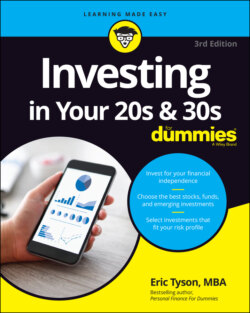Читать книгу Investing in Your 20s & 30s For Dummies - Eric Tyson - Страница 44
Assessing Your Risk-Taking Desires
ОглавлениеWith money that you’re investing for shorter-term goals, you have a more limited menu of investments to choose among. For your emergency/rainy-day fund, for example, you should consider only a money market fund or bank/credit union savings account. Down-payment money for a home purchase that you expect to make in a few years should be kept in short-term bonds.
When you’re younger and have more years until you plan to use your money, you should keep larger amounts of your long-term investment money in growth (ownership) investments, such as stocks, real estate, and small business. The attraction of these types of investments is their potential to really grow your money, but the risk is that the value of such investments can fall significantly.
The younger you are, the more time your investments have to recover from a bad fall. A long-held guiding principle says to subtract your age from 110 and invest the resulting number as a percentage of money to place in growth (ownership) investments. So if you’re 30 years old, 110 − 30 = 80 percent in growth investments
Should you want to be more conservative, subtract your age from 100: 100 − 30 = 70 percent in growth investments.
Want to be even more aggressive? Subtract your age from 120: 120 − 30 = 90 percent in growth investments.
These guidelines are general ones that apply to money that you invest for the long term (ideally, for ten years or more). In your younger adult years, you can consider investing all of your money in retirement accounts in stocks and stock funds given the long time frame you have with such accounts.
